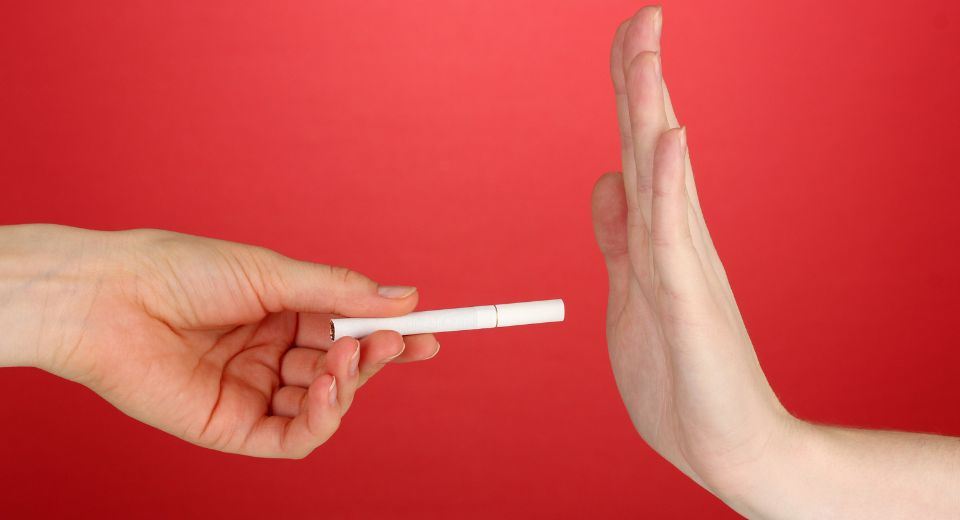
Author: Alison Sims, MD
May is National Tobacco Awareness month. Tobacco is a plant grown for its leaves, which are dried and fermented before being put in tobacco products. Tobacco contains nicotine, the ingredient that can lead to addiction.
Of the 250 harmful ingredients in tobacco products, these are a few of the infamous toxins and carcinogens that you may recognize: arsenic, benzene, nickel, chromium, cadmium, beryllium, hydrogen cyanide, carbon monoxide, ammonia and formaldehyde. According to the National Institute on Drug Abuse, the nicotine in any tobacco product readily absorbs into the blood when a person uses it. Upon entering the blood, nicotine immediately stimulates the adrenal glands to release the hormone epinephrine (adrenaline). Epinephrine stimulates the central nervous system and increases blood pressure, breathing, and heart rate. As with drugs such as cocaine and heroin, nicotine activates the brain’s reward circuits and also increases levels of the chemical messenger dopamine, which reinforces rewarding behaviors. Studies suggest that other chemicals in tobacco smoke, such as acetaldehyde, may enhance nicotine’s effects on the brain.
Smoking causes cancer of the lungs, esophagus, larynx, mouth, throat, kidney, bladder, pancreas, stomach, and cervix as well as acute myeloid leukemia. It also causes heart disease, peripheral vascular disease, strokes, chronic obstructive lung disease (COPD), emphysema, asthma, chronic bronchitis, aortic aneurysms, and hip fractures. These are all devastating illnesses that can cause severe disability and even premature death.
Most alarmingly, smoking is THE leading cause of premature, preventable deaths in the U.S. and over 440,000 people die each year from tobacco-related diseases. By simply kicking the habit at the age of 30, you can reduce your risk of dying of one of these tobacco-related diseases by 90 percent! If you quit by 50, you reduce your risk 50 percent. If you quit at 60 or older, you will live longer than those who continue to smoke. It is also estimated that someone living with a smoker has about a 30% increased risk of getting lung cancer or heart disease. Children living with a smoker have an increased risk of SIDS, infections, and asthma.
The first step in quitting is wanting to quit. The nicotine in tobacco products is highly addictive, and the addiction is similar to that of heroin or cocaine. In order to beat this addiction, you need to be very motivated, and carefully plan the removal of tobacco from your daily life, and seek help. You will likely have relapses, but keep trying.
To help quit your tobacco addiction, list your smoking habits and examine why and when you smoke. List your reasons for quitting, choose a quit date that is important to you, and be sure to involve family and friends to help you. Choose low calorie substitutes for when you crave tobacco such as gum, hard candies, or celery sticks. Drink lots of water. Exercise daily to reduce your cravings, manage stress, and avoid weight gain.
The symptoms of nicotine withdrawal can be more than just craving. Be aware that you may have anxiety, tension, restlessness, frustration, difficulty concentrating, difficulty sleeping, drowsiness, headaches, increased appetite, irritability or depression. Wean yourself slowly by using nicotine gum, patches, spray or inhalers. If you find that doesn’t help, you may want to see your physician about an antidepressant for a short-term aid.
For more ideas go to www.smokefree.gov where you can find a Step-by-Step Quit Guide, Live Support by trained counselors, and cool Tools such as the QuitGuide mobile app that sends encouraging texts and tips to your phone 24/7. There is even an online savings calculator to find out how much money you can save! Buy yourself something special as a reward. You deserve it!
The information provided is for general interest only and should not be misconstrued as a diagnosis, prognosis or treatment recommendation. This information does not in any way constitute the practice of medicine, or any other health care profession. Readers are directed to consult their health care provider regarding their specific health situation. Marque Medical is not liable for any action taken by a reader based upon this information.


